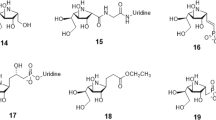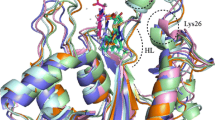Abstract
Glucosamine synthase (E.C. 2.6.1.16) is a promising target in antifungal drug design. It has been reported that its potent inhibitor, N3-(4-methoxyfu-maroyl)-L-2,3-diaminopropanoic acid (FMDP), inactivates the enzyme by the Michael addition of the S-H group to the FMDP molecule followed by cyclisation reactions. In this study we have investigated, by means of semiempirical MNDO, PM3 and molecular mechanics methods, the energetics and kinetic possibility of the formation of various stereoisomers of the products of cyclisation of the Michael addition products detected experimentally. It was found that the substituted 1,4-thiazin-3-one can be formed in one step under alkaline conditions; the stereoisomers of this compound predicted to be the most stable on the basis of theoretical calculations are also the dominant ones in reality.
Similar content being viewed by others
Abbreviations
- FMDP:
-
N3-(4-methoxyfumaroyl)-L-2,3-diaminopropanoic acid
- MNDO:
-
Modified Neglect of Diatomic Overlap
- AM1:
-
Advanced Method 1
- PM3 (full abbreviation: MNDOPM3):
-
Modified Neglect of Diatomic Overlap, Parametrised Method 3
References
Aihara A (1953) The vapor pressure of σ-valerolactam. J Chem Soc Japan, Pure Chem Sect 74:631–634
Andruszkiewicz R, Chmara H, Milewski S, Borowski E (1986) Synthesis of Na-(4-methoxyfumaroyl)-L-2,3-diaminopropanoic acid analogues, the irreversible inhibitors of glucosamine synthase. Int J Peptide Protein Res 27:449–453
Andruszkiewicz R, Chmara H, Milewski S, Borowski E (1987) Synthesis and biological properties of N3-(4-methoxyfumaroyl)-L-2,3-diaminopropanoic acid dipeptides — a novel group of antimicrobial agents. J Med Chem 30:1715–1719
Andruszkiewicz R, Milewski S, Zieniawa T, Borowski E (1990) Anticandidal properties of N3-(4-methoxyfumaroyl)-l-2,3-di-aminopropanoic acid oligopeptides. J Med Chem 33:132–135
Argay G, Kálmán A (1973) Crystal structure of 3-phenylpyrrolidine2,5-dione. Acta Cryst B29:636–638
Dewar MJS, Thiel W (1977) Ground states of molecules. 38. The MNDO method. Approximations and parameters. J Am Chem Soc 99:4899–4917
Kucharczyk N, Denisot M-A, Le Goffic F, Badet B (1990) Glucosamine-6-phosphate synthase from Escherichia coli: Determination of the mechanism of inactivation by N3-(4-methoxy-fumaroyl)-l-2,3-diaminopropanoic derivatives. Biochemistry 29:3668–3676
Leitão MLP, Pilcher G, Meng-Yan Y (1990) Enthalpies of combustion of γ-butyrolactone, γ-valerolactone, and δ-valerolactone. J Chem Theromdyn 22:885–891
Meng-Yan Y, Pilcher G (1990) Enthalpies of combustion of succinic anhydride, glutaric anhydride, and glutarimide. J Chem Thermodyn 22:893–898
Milewski S, Chmara H, Andruszkiewicz R, Borowski E (1985) Synthetic derivatives of N3-(4-methoxyfumaroyl)-l-2,3-diamino-propanoic acid inactivate glucosamine synthase from Candida albicans. BBA 828:247–254
Milewski S, Chmara H, Andruszkiewicz R, Borowski E, Zaremba M, Borowski J (1988) Antifungal peptides with novel specific inhibitors of glucosamine-6-phosphate synthase. Drugs Exptl Clin Res 14:461–465
Romers C, Rutten EWM, Van Driel CAA, Sanders WW (1967) The conformation of nonaromatic ring compounds. XXVIII. The crystal structure of α-chloro-δ-valerolactam. Acta Cryst 22: 893–899
Stewart JJP (1989a) Optimization of parameters for semiempirical methods. I. Method J Comput Chem 10:209–220
Stewart JJP (1989b) Optimization of parameters for semiempirical methods. II. Applications. J Comput Chem 10:221–264
Stewart JJP (1990) MOPAC — A semiempirical molecular orbital program. J Comput-Aided Mol Design 4:1–105
Strepikheev AA, Skuratov SM, Shteker SM, Muromova RS, Brykina EP, Kachinskaya ON (1955) Strain in lactams. Dokl Akad Nauk SSSR 102:105–108
Tempczyk A, Tarnowska M, Liwo A (1989) A theoretical study of glucosamine synthase. Part I — Molecular mechanics calculations on substrate binding. Eur Biophys J 17:201–210
Tempczyk A, Tarnowska M, Liwo A, Borowski E (1992) A theoretical study of glucosamine synthase. Part II — Combined quantum and molecular mechanics simulation of sulfhydryl attack on carboxyamide group. Eur Biophys J, in the press
Voityuk AA, Bliznyuk AA (1987) MNDO calculations of systems containing hydrogen bonds. Theor Chim Acta 72:223–228
Weiner SJ, Kolman PA, Nguyen DT, Case DA (1986) An all-atom force field for simulations of proteins and nucleic acids. J Comput Chem 7:230–252
Author information
Authors and Affiliations
Additional information
Correspondence to: A. Liwo
Rights and permissions
About this article
Cite this article
Tarnowska, M., Oldziej, S., Liwo, A. et al. Investigation of the inhibition pathway of glucosamine synthase by N3-(4-methoxyfumaroyl)-L-2,3-diaminopropanoic acid by semiempirical quantum mechanical and molecular mechanics methods. Eur Biophys J 21, 273–280 (1992). https://doi.org/10.1007/BF00185122
Received:
Accepted:
Issue Date:
DOI: https://doi.org/10.1007/BF00185122




